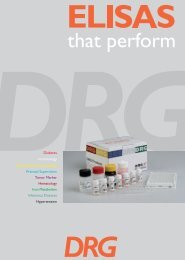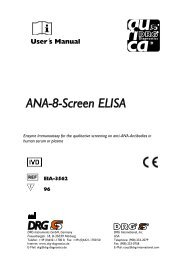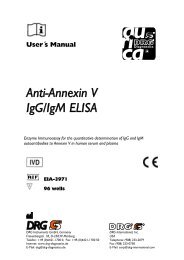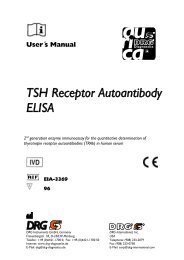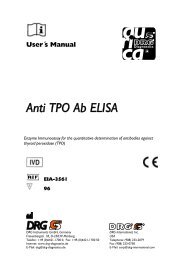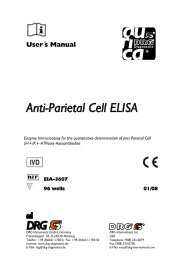Treponema pallidum (Syphilis) IgM ELISA - DRG Diagnostics GmbH
Treponema pallidum (Syphilis) IgM ELISA - DRG Diagnostics GmbH
Treponema pallidum (Syphilis) IgM ELISA - DRG Diagnostics GmbH
You also want an ePaper? Increase the reach of your titles
YUMPU automatically turns print PDFs into web optimized ePapers that Google loves.
<strong>DRG</strong> <strong>Treponema</strong> <strong>pallidum</strong> <strong>IgM</strong> <strong>ELISA</strong> EIA-4267<br />
6.2 Assay Procedure<br />
Prior to commencing the assay, dilute Wash Solution, prepare patient samples as described in point 5.3<br />
and establish carefully the distribution and identification plan supplied in the kit for all specimens and<br />
controls.<br />
1. Select the required number of microtiter strips or wells and insert them into the holder.<br />
Please allocate at least:<br />
1 well (e.g. A1) for the substrate blank,<br />
1 well (e.g. B1) for the Neg. Control,<br />
2 wells (e.g. C1+D1) for the Cut-off Control and<br />
1 well (e.g. E1) for the Pos. Control.<br />
2.<br />
It is left to the user to determine controls and patient samples in duplicate.<br />
Dispense<br />
100 µL of Neg. Control into well B1<br />
100 µL of Cut-off Control into wells C1 and D1<br />
100 µL of Pos. Control into well E1 and<br />
3.<br />
100 µL of each p r e a t r e a t e d sample with new disposable tips into appropriate wells.<br />
Leave well A1 for substrate blank!<br />
Cover wells with foil supplied in the kit. Incubate for 60 minutes at 37 °C.<br />
4. Briskly shake out the contents of the wells.<br />
Rinse the wells 5 times with diluted Wash Solution (300 µL per well). Strike the wells sharply on<br />
absorbent paper to remove residual droplets.<br />
Important note:<br />
The sensitivity and precision of this assay is markedly influenced by the correct performance of the<br />
washing procedure!<br />
5. Dispense 100 µL Enzyme Conjugate into each well, except A1.<br />
6. Cover wells with foil. Incubate for 30 minutes at room temperature (20°C to 25°C).<br />
Do not expose to direct sun light!<br />
7. Briskly shake out the contents of the wells.<br />
Rinse the wells 5 times with diluted Wash Solution (300 µL per well). Strike the wells sharply on<br />
absorbent paper to remove residual droplets.<br />
8. Add 100 µL of Substrate Solution into all wells.<br />
9. Cover wells with foil. Incubate for exactly 15 minutes at room temperature (20 °C to 25 °C)<br />
in the dark.<br />
10. Stop the enzymatic reaction by adding 100 µL of Stop Solution to each well.<br />
Any blue color developed during the incubation turns into yellow.<br />
Note: Highly positive patient samples can cause dark precipitates of the chromogen!<br />
11. Read the optical density at 450/620 nm with a microtiter plate reader within 30 minutes after adding<br />
the Stop Solution.<br />
6.3 Measurement<br />
Adjust the <strong>ELISA</strong> microplate or microstrip reader to zero using the substrate blank in well A1.<br />
If - due to technical reasons - the <strong>ELISA</strong> reader cannot be adjusted to zero using the substrate blank in well<br />
A1, subtract the absorbance value of well A1 from all other absorbance values measured in order to obtain<br />
reliable results!<br />
Measure the absorbance of all wells at 450 nm and record the absorbance values for each control and<br />
patient sample in the distribution and identification plan.<br />
Dual wavelength reading using 620 nm as reference wavelength is recommended.<br />
Where applicable calculate the mean absorbance values of all duplicates.<br />
Vers. 7.0 Effective 2009/11 – sl - 6 -



